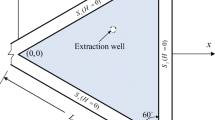Abstract
A general model for time‐dependent saturated–unsaturated waterflow caused by a single well with a given radius is presented. The storage capacity of the well tube is taken into account. The inflow into the well (with drainage) is modeled using the Signorini boundary condition. The nonconforming mixed finite element method on a multilevel adaptive grid is used for the solution of the radial symmetric, time dependent problem. Finally, van Genuchten parameters of an aquifer are determined from field measurements by inverse computations.
Similar content being viewed by others
References
D.N. Arnold and F. Brezzi, Mixed and nonconforming finite element methods: Implementation, postprocessing and error estimates, Math. Modelling Numer. Anal. 19(1) (1985) 7–32.
C. Baiocchi and A. Capelo, Variational and Quasivariational Inequalities (Wiley, Chichester, 1984).
G. Duvaut and J.L. Lions, Inequalities in Mechanics and Physics (Springer, Berlin, 1976).
D. Gilbarg and N.S. Trudinger, Elliptic Partial Differential Equations of Second Order (Springer, Berlin, 1983).
R.H.W. Hoppe and B. Wohlmuth, Adaptive multilevel techniques for mixed finite element discretizations of elliptic boundary value problems, SIAM J. Numer. Anal. 34(4) (1997) 1658–1681.
S.P. Neumann and P.A. Witherspoon, Analysis of nonsteady flow with a free surface using the finite element method, Water Resources Research 7(3) (1971) 611–623.
I.S. Papadopulos and H.H. Cooper Jr, Drawdown in a well of large diameter, Water Resources Research 3(1) (1967) 241-244.
E.A. Sudicky, A.J.J. Unger and S. Lacombe, A noniterative technique for the direct implementation of well bore boundary conditions in three dimensional heterogeneous formations, Water Resources Research 31(2) (1995) 411–415.
C.V. Theis, The relation between the lowering of the piezometric surface and the rate and duration of discharge of a well using groundwater storage, Trans. Amer. Geophys. Union 16(1) (1935) 519–524.
M.Th. van Genuchten, A closed-form for predicting the hydraulic conductivity of unsaturated soils, Soil Sci. Soc. Am. J. 44 (1980) 892–898.
H. Vereecken, U. Döring, W. Drost, A. Georgescu, U. Jaekel, O. Neuendorf and R. Seidemann, Analysis of reactive solute transport in a heterogeous aquifer: The Krauthausen field experiment. 2. Determination of the hydraulic conductivity and local velocities, Water Resources Research, submitted.
Author information
Authors and Affiliations
Rights and permissions
About this article
Cite this article
Schumacher, S., Slodička, M. & Jaekel, U. Well modeling and estimation of hydraulic parameters. Computational Geosciences 1, 317–331 (1997). https://doi.org/10.1023/A:1011529614975
Issue Date:
DOI: https://doi.org/10.1023/A:1011529614975




